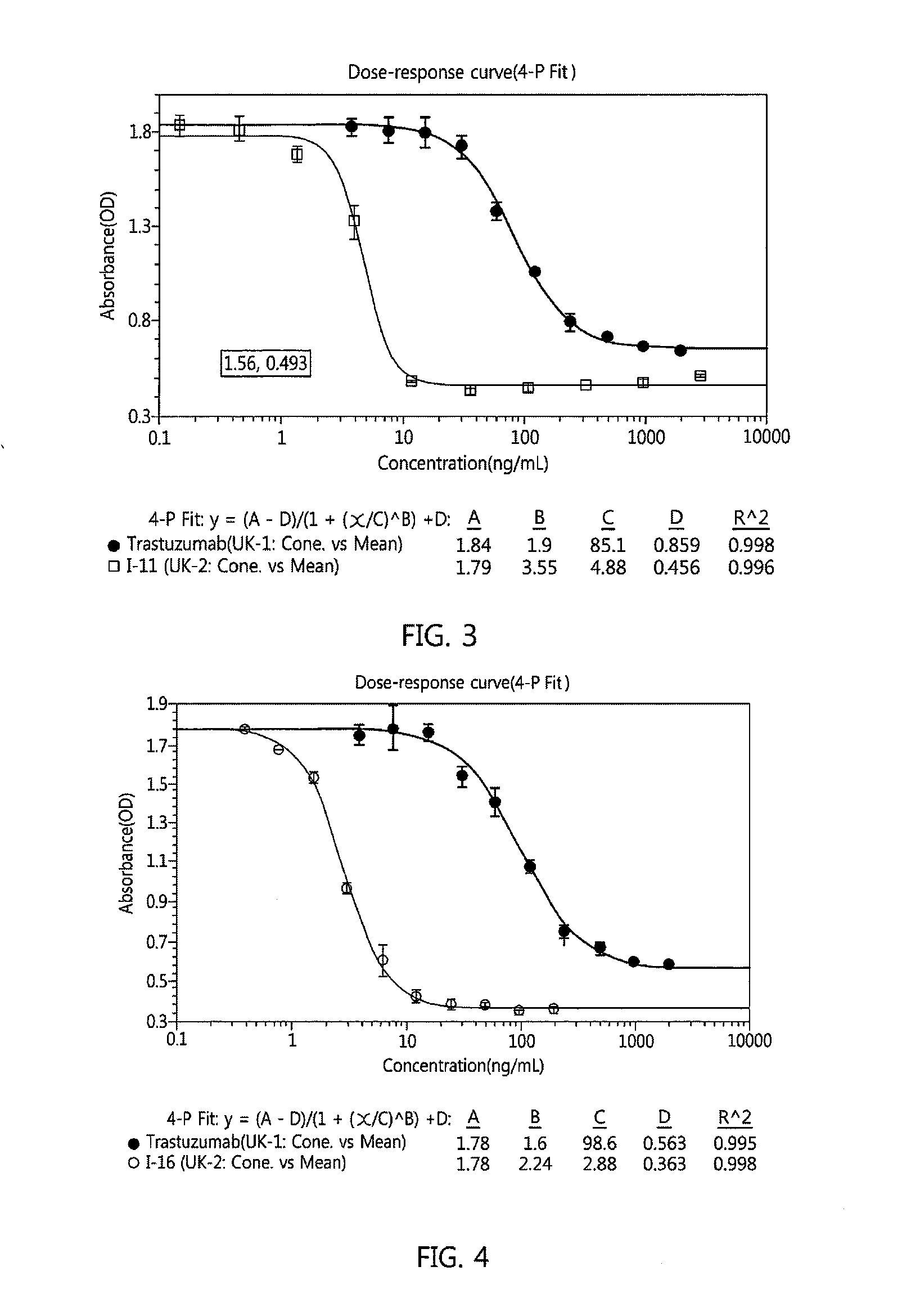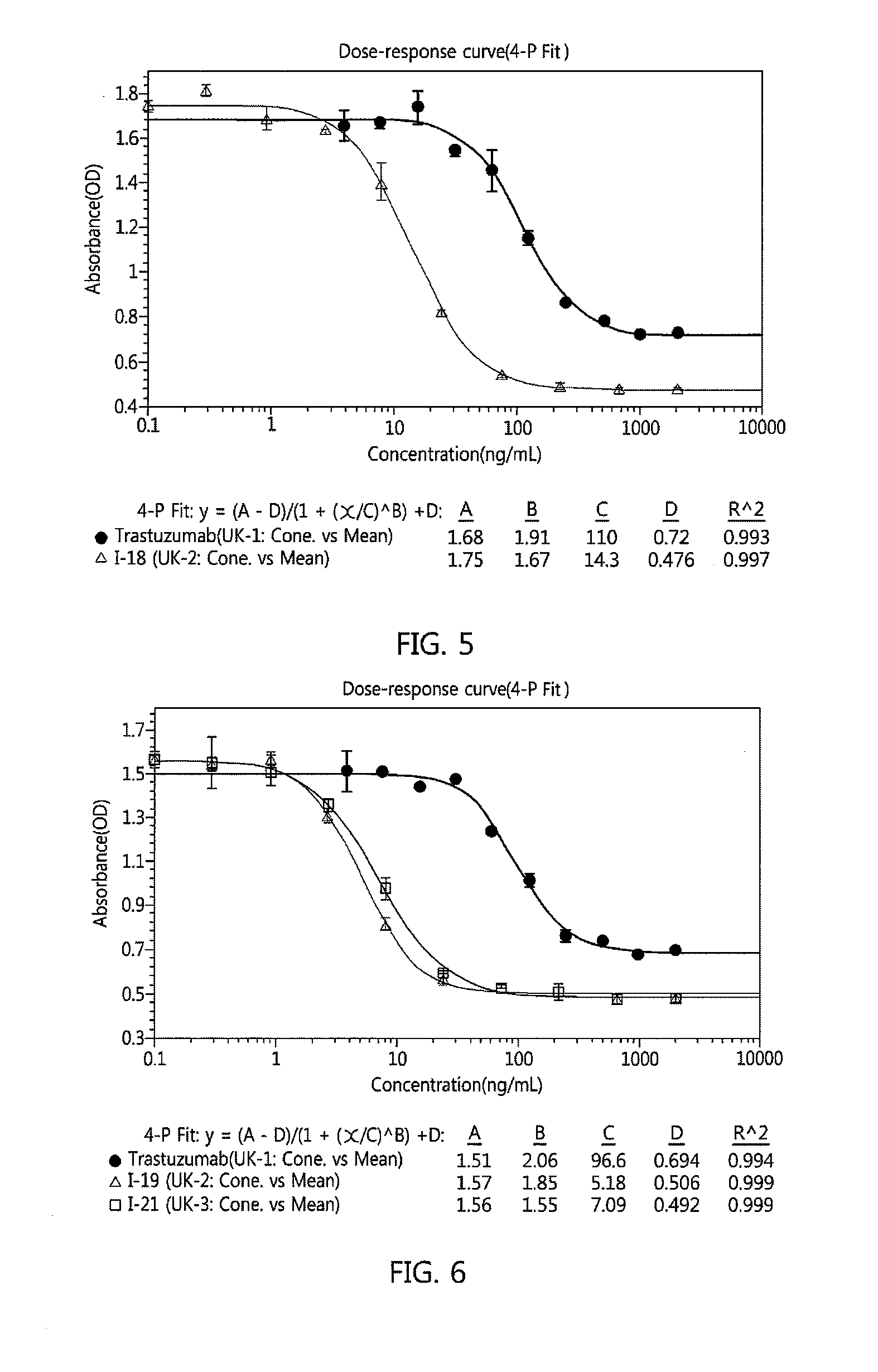Antibody-linker-drug conjugate, preparation method therefor, and anticancer drug composition containing same
a technology of antibody-linker and conjugate, which is applied in the field of antibody-linkerdrug conjugate, preparation method therefor, and anticancer drug composition containing same, can solve the problems of negative influence of antibody affinity to its antigen, all antibodies, and cancer progression, and achieves high yield, effective and selective delivery of cytotoxic drugs, and high yield
- Summary
- Abstract
- Description
- Claims
- Application Information
AI Technical Summary
Benefits of technology
Problems solved by technology
Method used
Image
Examples
preparation example 1
Preparation of Compounds of Chemical Formula II-1 and II-2
preparation example 1-1
Preparation of Compound (II-1)
[0217]
[0218]Under an argon stream, 6-(2,5-dioxo-2,5-dihydro-1H-pyrrol-1-yl)-N—((S)-1-(((S)-1-(4-(hydroxymethyl)phenyl)amino)-1-oxo-5-ureidopentan-2-yl)amino)-3-methyl-1-oxobutan-2-yl)hexanamide (5.0 g, 8.7 mmol, Dubowchik et al., Bioconjugate Chem., 2002, 13 (4), pp 855-869) was dissolved in 60 mL of anhydrous dimethylformamide, added with N, N-diisopropylethylamine (3.0 mL, 17.4 mmol), and cooled to 0° C. To the mixture was added at once bis(4-nitrophenyl) carbonate (7.94 g, 26.1 mmol), followed by stirring at room temperature for 15 hrs. After completion of the reaction, the reaction mixture was concentrated in a vacuum, and the concentrate was purified by silica gel column chromatography to obtain the title compound (3.65 g, 57%) as a pale yellow solid.
[0219]1H NMR (400 MHz, DMSO-d6) δ 0.83 (d, J=6.8 Hz, 3H), 0.86 (d, J=6.8 Hz, 3H), 1.09 (t, J=7.2 Hz, 1H), 1.19 (m, 2H), 1.34-1.76 (m, 7H), 1.96 (m, 1H), 2.15 (m, 2H), 2.99 (m, 2H), 3.37 (m, 2H), 4.19 ...
preparation example 1-2
Preparation of Compound (II-3)
[0220]
[0221]Under an argon stream, 6-(2,5-dioxo-2,5-dihydro-1H-pyrrol-1-yl)-N—((S)-1-(((S)-1-((4-(hydroxymethyl)phenyl)amino)-1-oxo-5-ureidopentan-2-yl)amino)-3-methyl-1-oxobutan-2-yl)hexanamide (5.0 g, 8.7 mmol, Dubowchik et al., Bioconjugate Chem., 2002, 13 (4), pp 855-869) was dissolved in 60 mL of anhydrous dimethylformamide, added with N, N-diisopropylethylamine (3.0 mL, 17.4 mmol), and then cooled to 0° C. To the mixture was added at once bis(4-nitrophenyl) carbonate (7.94 g, 26.1 mmol), followed by stirring at room temperature for 15 hrs. After completion of the reaction, the reaction mixture was concentrated in a high vacuum, and the concentrate was purified by silica gel column chromatography to obtain 4-((S)-2-((S)-2-(6-(2,5-dioxo-2,5-dihydro-1H-pyrrol-1-yl)hexanamido)-3-methylbutanamido)-5-ureidopentanamido)benzyl (4-nitrophenyl) carbonate (3.65 g, 57%) as a pale yellow solid.
[0222]1H NMR (400 MHz, DMSO-d6) δ 0.83 (d, J=6.8 Hz, 3H), 0.86 (d, ...
PUM
 Login to View More
Login to View More Abstract
Description
Claims
Application Information
 Login to View More
Login to View More - R&D
- Intellectual Property
- Life Sciences
- Materials
- Tech Scout
- Unparalleled Data Quality
- Higher Quality Content
- 60% Fewer Hallucinations
Browse by: Latest US Patents, China's latest patents, Technical Efficacy Thesaurus, Application Domain, Technology Topic, Popular Technical Reports.
© 2025 PatSnap. All rights reserved.Legal|Privacy policy|Modern Slavery Act Transparency Statement|Sitemap|About US| Contact US: help@patsnap.com



